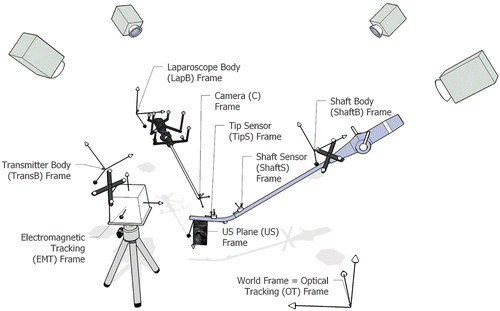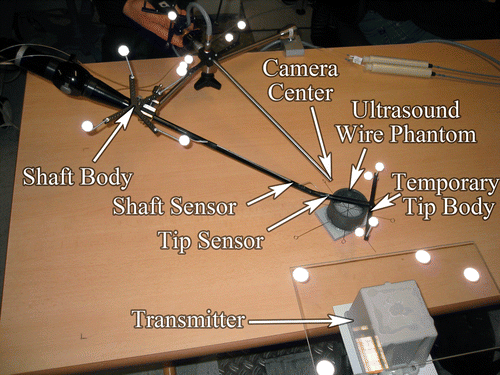Figures & data
Figure 1. Coordinate frames associated with our hybrid magneto-optic tracking setup to localize the laparoscope and the tip of the laparoscopic ultrasound.

Figure 2. Screenshot of axis segmentation. Lines classified as belonging to the transducer tip edges are automatically colored yellow; lines belonging to the transducer (but not to the edges) are colored blue; and the corrected transducer axis is the thick red line. Lines belonging to the pencil are rejected (colored green), because they do not match the measured transducer axis rotation. [Color version available online.]
![Figure 2. Screenshot of axis segmentation. Lines classified as belonging to the transducer tip edges are automatically colored yellow; lines belonging to the transducer (but not to the edges) are colored blue; and the corrected transducer axis is the thick red line. Lines belonging to the pencil are rejected (colored green), because they do not match the measured transducer axis rotation. [Color version available online.]](/cms/asset/a1535079-10fc-4263-b99e-8108e7e2e93c/icsu_a_331167_f0002_b.gif)
Figure 3. Back-projection of a segmented line and its comparison to the transducer tip axis measured by EMT. [Color version available online.]
![Figure 3. Back-projection of a segmented line and its comparison to the transducer tip axis measured by EMT. [Color version available online.]](/cms/asset/35c6c0ec-7e59-443b-8874-4467f3c57fe2/icsu_a_331167_f0003_b.gif)
Figure 4. Back-projection of four segmented lines, which generates four planes and their corresponding normals n1, n2, n3, and n4 (plane coloring according to ). For each plane j, its distance dj to bC and angle αj to dC are computed. We suppose that all four planes satisfy |αj| < 5° and |dj| < 30 mm. Because d1 is the maximum positive distance from bC, and d4 the maximum negative distance from bC, we can set dposmax = d1 and dnegmax = d4. If |dposmax − dnegmax| = |d1 − d4| stays within 10 ± 2 mm, we continue our computations. For all distances i unequal dposmax and dnegmax, we check whether dposmax − di < 2 mm or di − dnegmax < 2 mm. All planes not satisfying this criterion are excluded from further computations, as for plane 2 (blue). Using the remaining three yellow planes, a mean plane (red) defined by and
is determined. The transducer tip axis can finally be translated along
for dest = 0.5(d1 + d4) mm and rotated by
around
. [Color version available online.]
![Figure 4. Back-projection of four segmented lines, which generates four planes and their corresponding normals n1, n2, n3, and n4 (plane coloring according to Figure 2). For each plane j, its distance dj to bC and angle αj to dC are computed. We suppose that all four planes satisfy |αj| < 5° and |dj| < 30 mm. Because d1 is the maximum positive distance from bC, and d4 the maximum negative distance from bC, we can set dposmax = d1 and dnegmax = d4. If |dposmax − dnegmax| = |d1 − d4| stays within 10 ± 2 mm, we continue our computations. For all distances i unequal dposmax and dnegmax, we check whether dposmax − di < 2 mm or di − dnegmax < 2 mm. All planes not satisfying this criterion are excluded from further computations, as for plane 2 (blue). Using the remaining three yellow planes, a mean plane (red) defined by and is determined. The transducer tip axis can finally be translated along for dest = 0.5(d1 + d4) mm and rotated by around . [Color version available online.]](/cms/asset/23d18bea-4b31-4b1a-9436-6ca42eb3c015/icsu_a_331167_f0004_b.gif)
Figure 6. ROC curves for error prediction. (a) Prediction of an error of 5.0 mm or greater. (b) Prediction of an error of 7.5 mm or greater.

Table I. Distortion detection rate by our distrust level without distortion, with static, and with dynamic field distortion.
Table II. Receiver operating characteristic key figures for prediction of distortion errors of at least 2.5, 5, 7.5, and 10 mm.
Table III. Overlay errors in an undistorted and a distorted field.

![Figure 7. Ultrasound plane augmented on the laparoscope video – the red line is added manually to show the extension of the straight wire, which matches its ultrasound image. [Color version available online.]](/cms/asset/68f0d0a1-236b-4d65-84b4-1b43bd22c783/icsu_a_331167_f0007_b.gif)